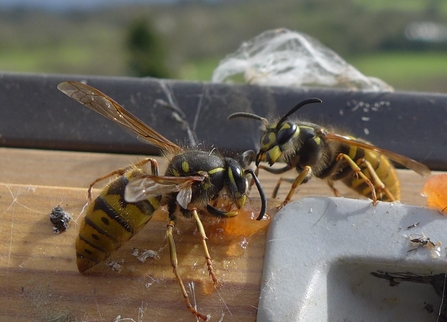Unless you are seriously allergic to the stings (and possibly even if you are), I hope my discovery will enable you to sit outside in a beautiful flowery garden all summer, with Common Wasps flying by and ignoring you, along with the bees, the hoverflies and some of the approximately 9,000 other species of UK wasps.
Before I reveal my breakthrough, here is some information...
What are wasps for?
Wasps belong in our natural ecosystem. Tragically slowly, humanity is realising that we cannot pick and choose which parts of the ecosystem to label as pests and kill off. Everything has evolved to coexist together as part of the whole. The more we upset the balance, the more we affect our whole intricate environment.
Common Wasps are predators of our garden ‘pests’. As apex predators living in large colonies, they help gardeners by massively reducing the numbers of aphids, caterpillars and insect grubs that eat our food plants. They also prey on other common invertebrates, from woodlice to spiders, so that the balance of nature doesn’t go out of kilter. They feed all the victims to their young, providing a natural and effective pest control, unlike indiscriminate chemical pesticides.
Wasps are pollinators, and they pollinate our cultivated flowers and crops as well as native wild flowers. This fact is the key to my secret, which will be revealed soon.
Wasps are architects. Have you ever seen a wasp using her mandibles to scratch up wood from a garden fence, shed or seat? She’s a dedicated crafter gathering her materials to help build an architectural wonder. As it grows, the nest resembles a trendy spherical lampshade, perhaps about the size of a football. Inside are symmetrical hexagonal cells shaped like honeycomb but neither made of wax nor full of honey. As the originators of papier mâché nests, wasps may well have inspired the Chinese to invent paper.
Wasps are highly developed social beings, living in a community. Each worker is devoted to building and supporting the next generation, passing on their own genes.
Wasps may be useful in medicine. Wasp venom could become a future cure for cancer. Research is ongoing on the venom of tropical social wasps.
The Common Wasp life cycle
Having mated once, a queen emerges from hibernation to build the first cells of her nest, laying one egg in each. After about a month, adult female workers emerge and begin foraging, nest building and feeding the young, while the queen lays more eggs. Workers feed the larvae on prey and in return, the larvae feed their carers a sugary reward.
Apparently, unmated workers can lay unfertilised eggs, which turn into male wasps, but there is competition: some workers’ eggs are eaten by rivals. Mated queens produce fertile eggs that hatch out as females, although later in the season a queen can also lays eggs that become males.
Once the colony is big enough and before the end of summer, males and young emerged queens mate. Once this last generation has pupated, there are no young left to feed the workers. They become desperately hungry, hence the bothering behaviour at picnics. Fertilised queens hibernate but the workers will soon die.
German wasps (Vespula germanica)
If you find a greyish nest and larger wasps (but smaller than hornets), they are probably German Wasps, which look very similar to Common Wasps. They tend to make nests in the ground, so maybe this is the sort I once fell on (with no nasty consequences, despite angry wasps climbing up my legs). Common Wasps often nest in the ground, too, though. Fortunately, German Wasps are native and non-aggressive … unless someone falls on their nest.


